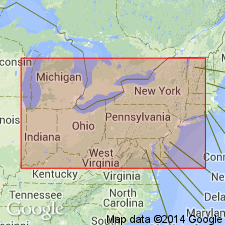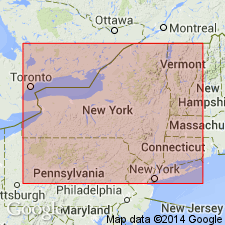
- Usage in publication:
-
- Stony Hollow member
- Modifications:
-
- Named
- Dominant lithology:
-
- Sandstone
- AAPG geologic province:
-
- Appalachian basin
Summary:
Pg. 179-180. [Stony Hollow member of Marcellus formation named in this report. Unit extends from southeastern New York to northeastern Pennsylvania.] Chiefly fine-grained calcareous sandstone 75 to 100 feet thick. Underlies Mount Marion formation of Grabau at its type section. Beds formerly classified as "Marcellus" shale (Bakoven of Chadwick) immediately underlie Stony Hollow member and are now proved to be equivalent of Union Springs member. Southwest of Albany, layers of limestone appear in upper part of sandstone which has thinned to 24 feet; west of Onesquethaw Creek, these limestones of the Stony Hollow become the Cherry Valley limestone as exposed in Stony Creek, Schoharie Valley.
Type section: at bend of NY Highway 28, and along railroad opposite bend at entrance to valley leading up to settlement of Stony Hollow, 1.75 to 2 mi northwest of bridge over Esopus Creek on west side of Kingston, Ulster Co., [NY]. Also present along U.S. Highway 209, near Echo Lake, Monroe Co., PA.
Age is Middle Devonian (Cooper and others, 1942, GSA Bull., v. 53, no. 12, pt. 1, p. 1783).
[See also G.A. Cooper, IN Goldring, Winifred, 1943, New York State Mus. Bull., no. 332, p. 247-248. Available online from the New York State Library Digital Collections: http://www.nysl.nysed.gov/index.html (Type "332" in search field).]
Source: US geologic names lexicon (USGS Bull. 1200, p. 3740).

- Usage in publication:
-
- Stony Hollow Member
- Modifications:
-
- Revised
- AAPG geologic province:
-
- Appalachian basin
Summary:
Marcellus Formation will be "formally" raised to subgroup status within the Hamilton Group and be divided into a lower Union Springs Formation and an upper Mount Marion Formation (in eastern New York), and an upper Oatka Creek Formation (in central and western New York), in a publication by Ver Straeten and others (in prep). Union Springs Formation will incorporate three members across New York: the Bakoven Member (geographically extended across the State of New York), the Stony Hollow Member (restricted), and the Hurley Member (new). The Hurley underlies the Cherry Valley Member at the base of the laterally equivalent Mount Marion and Oatka Creek Formations. The Bakoven unconformably overlies the Seneca Member or, where absent, the Moorehouse Member of the Onondaga Formation. The Stony Hollow formerly represented all calcareous shale and sandstone above the Bakoven Member and below the Mount Marion Formation in eastern New York. As proposed, the Stony Hollow Member is restricted to strata underlying the new Hurley Member and the revised Cherry Valley Member in eastern New York.
["Subgroup" not recognized as a formal stratigraphic rank term (CSN, 1933; ACSN, 1961, 1970; NACSN, 1983, 2005, 2021). Considered informal and should not be capitalized.]
Source: Modified from GNU records (USGS DDS-6; Reston GNULEX).
For more information, please contact Nancy Stamm, Geologic Names Committee Secretary.
Asterisk (*) indicates published by U.S. Geological Survey authors.
"No current usage" (†) implies that a name has been abandoned or has fallen into disuse. Former usage and, if known, replacement name given in parentheses ( ).
Slash (/) indicates name conflicts with nomenclatural guidelines (CSN, 1933; ACSN, 1961, 1970; NACSN, 1983, 2005, 2021). May be explained within brackets ([ ]).

